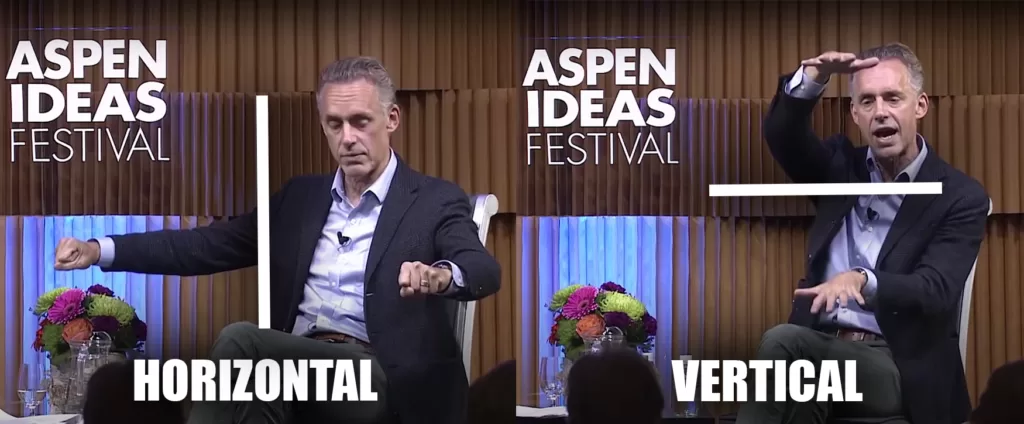How to be More Articulate (The Pattern)
Have you ever noticed how you can’t seem to articulate like you think? While your arguments may be very interesting and organized, how you explain them makes them lose all appeal.
I’ve studied the most articulate speakers in the world and noticed the four most common patterns they use to explain complex topics easily.
These patterns can be easy to follow and will help you be more articulate.
However, we need to go through nine basic rules you shouldn’t break if you want to be more articulate before we delve into the four ways to explain any of your thoughts and arguments.
Remember, competence comes faster with deliberate practice. And awareness & observation will bring changes passively. Even if you practice just one rule vigorously for weeks, your improvement will skyrocket.
More on “how to practice” later.
Before you Begin:
1. These rules & tactics might not be optimal for writing.
2. Throughout this article, we’ll imagine our listener is a “she”.
Rules to be more articulate.
I’ll start with some general rules that alone can help you be more articulate. These rules are good guidelines to give some structure to the 1000s of articulation tips available online, which aren’t practicable.
I have come up with 10 (more will be added) rules to be more articulate that give the most results are easier to practice & that very few people know about (strangely).
Rule 1: Explanation always moves from broad to more specific.
Whenever people asked Jimmy a question about computers, he would always respond with overly technical information that left them struggling to understand about 40% of what he said.
Then he’d think, “Oh no, she didn’t get anything, did she?” and start explaining more broadly.
So, after saying:
“Your PC has got a Polymorphic virus. That alters its signature patterns wherever it gets duplicated and can convert its attribute into the underlying code without converting the fundamental functions.”
He’d just say:
“Your PC has got a complicated virus that causes data loss”.
She understood it eventually, but he should’ve started in the correct order to be more articulate.
Remember:
It’s important to remember that people learn things in a certain order, and it’s a mistake to assume otherwise. When articulate people explain something, they start with the basics and then add more details step by step (if needed). This method helps everyone understand better unless the audience is full of nerds.
Here’s an example:
Q: What is the movie Ex Machina about?
So, instead of saying:
“It’s a story about a young programmer Caleb who gets selected in an AI research facility that’s at a very secluded location & is run by a very shady owner, has to do a Turing test of an advance AI robot.”
Start with:
“It’s a science fiction movie about an AI robot”.
Then, if she gives you a hint to be more specific like:
- “About an AI?”
- Or “So is it like Westworld?”
- Or just “AI?”
You’ll add a little more detail:
“Yeah, a young programmer gets selected to test an advanced AI robot, and it’s a story about him and the robot”.
Then, she can further give you a hint for more specificity, and you can respond accordingly.
Pro Tip: If she keeps asking for more details, maybe she just wants to spend more time with you, which will be a good opportunity to plan an Ex Machina movie night together.
Remember:
You don’t have to always answer the questions directly. Instead of directly telling her whether it’s like Westworld or not, just add more details about the movie.
Also, the hint doesn’t always have to be verbal, maybe there’s an awkward silence after you awkwardly describe what the movie is about very broadly. This brings us to Rule 2.
Rule 2: Bait specificity, don’t enforce it.
This rule is like a sequel to the first one.
What if there’s no hint to either keep going or to stop, like a period of awkward silence after you’ve explained something broadly?
Remember, silence is also a hint. It’s a hint to keep going. And now you already know how to keep going (from broader to more specific). So, just add more specificity.
Here’s an example from the same conversation about Ex Machina:
“It’s a science fiction movie about AI.”
Awkward silence for 1–2 seconds.
“A young programmer gets selected to test an advanced AI robot, and it’s a story about him and the robot.”
Awkward silence for 1-2 seconds.
“Have you watched Westworld?” Bait question to try an analogy to add more specificity and move the conversation forward.
“Yes”. Make sure the comparison is made with something she’s likely to know about.
“It’s like that a little, although there are fewer characters in the movie, only three, out of which one is the robot.”
I know I told you nothing about asking questions to bait specificity, so the next rule is exactly that.
Rule 3: Ask close-ended questions to improve engagement & comprehension.
A closed-ended question is one that only allows for a small number of responses or a brief & precise response like “yes” or “no.”
Did you notice how instead of adding more specificity in the last example I asked a close-ended question? I did it for a few reasons:
- The longer the explanation, the harder it becomes to keep the listener engaged. A simple trick to reset the “losing engagement meter” would be to make the listener recall, think, and speak a little. This will make the listener listen more attentively.
- Asking close-ended questions is a good way to improve comprehension, as your explanation will adapt to the listener, making you more concise and helping you be more articulate. You could keep talking & the listener could pretend to listen, but that defeats the purpose of your speech.
- It sometimes feels weird to keep adding details during an awkward silence.
So, asking bait questions will drastically make a conversation more interesting while helping you be more articulate at the same time.
Here’s another example:
While answering where you live, instead of just stating the landmark, ask her whether she knows where it is.
For example, “Do you know where the Manchester Cathedral is?”
She: “Yeah! I was there last night”.
You: “My house is just two minutes from there”.
Rule 4: Hand gestures are mandatory.
You’ll often notice articulate people using hand gestures, and there are a few reasons for that:
- Using gestures can improve engagement and comprehension.
It makes expressing yourself easier while putting you in the flow of talking. - People also tend to interrupt you less.
- You look confident and as a result, become more. So much so that it’s a good tool for people who have social anxiety and/or are shy.
It’s the opposite of having closed body language, which is a tendency of shy people.
Here are some simple rules to follow while using gestures:
- Make sure there’s space between your upper arms and your body while using gestures.
This rule makes you more energetic while talking, which is a good thing for shy people who tend to use small gestures.
It’s more masculine to use big gestures, if you want a feminine version just don’t follow this rule.

- Don’t use gestures unnecessarily. Make sure they’re meaningful. Moving your arms unnecessarily will do more harm than good.
- Try to show your palms while using gestures.
- Tight wrists (a little muscular tension) are masculine and loose wrists are feminine. Choose.
Rule 5: Hand Gestures divide the space into two at a time (only for beginners).

To understand how gestures work, this rule will be a good start. While explaining something to someone you often have to divide things in two, and you can use your arms to help the listener visualize the division.
So, either the space is divided into two horizontally like done here by Jordan Peterson when he uses space to differentiate between thinking in words vs. thinking in images:
Or the space is divided into two vertically, like done here again, by Jordan Peterson. He’s showing how one thing (stories) originated from something else (observing the biological ethics):
This way you can compare two things, show a timeline of one thing proceeding another, one thing giving rise to another, etc.
Read 20 Hand Gestures for Beginners to Copy to get started with gestures.
Rule 6: Enunciation is more important than volume.
It is a real concern for people to worry that their voice is too soft to maintain attention.
Low volume is not ideal for many situations, but do you know what’s more important?
Pronouncing every word clearly & not slurring.
Ifiwritelikethiswouldyouunderstand (If I write like this, would you understand)? If not, then speaking like this would also have the same effect.
We tend to underestimate how important this skill is. It’s comical how even the most articulate people have to repeat themselves sometimes due to too much slurring.
Tip:
The next time you talk to someone, assume that the listener isn’t a native speaker of your language. Pronounce each word correctly. This not only makes you appear intelligent but also puts you in a great psychological condition to be more articulate.
Don’t worry if this temporarily affects your other communication skills. They will soon return as proper and slow pronunciation becomes a habit
Rule 7: Use volume for comprehension and attention.
As previously stated, volume is important, and being louder can not only keep others’ attention, increase your energy, and make you feel better, but it can also help you slow down your speech.
Which will also make you more understandable.
When people are told to be louder, they tend to shout hurting their throats, and/or become monotonous.
So, instead of thinking, “I should be louder”, think, “I should be 10% louder“. You can speak louder using this mental cue without it seeming unnatural.
Although you might feel that a 10% improvement is too small, you won’t be just 10% louder because you’re not a robot.
Instead, you’ll just be, louder (might even become twice as loud, but don’t ever aim for that).
Try our 30-day challenge to make your voice significantly louder naturally: 30-Day Challenge: Make Your Speaking Voice Louder
Rule 8: Replace filler words with pauses & use pauses to think.
When you’re talking, you need time to think; and you’ll likely use filler words like “um,” “uh,” and “ah,” to do that. Which makes your sentences sound less concise and smooth.
You can use pauses to do that instead.
Plus, communication experts frequently recommend using pauses to sound more interesting. So, why don’t more people use pauses if they both help you think and sound more interesting?
Here’s the answer: Pauses can lead people to believe you’re done speaking. Making them either jump in (start speaking) and cut you off or shift their attention to something else.
However, it can be easily avoided by using gestures and pausing mid-sentences rather than at the end.
So instead of using “ahhhhhhh…” to tell people you’re thinking, use a gesture to hint at that, like looking up, closing your eyes, squeezing your eyes, putting your finger on your face, etc.
Plus, if someone cuts you off mid-sentence after you had taken a pause to think of the proper word, just speak over them by being a bit louder initially and then finish your sentence in your normal voice.
Rule 9: Don’t let others always cut you off mid-sentence.
Talking over you can become habitual for your friends, and your points could come across as not worthy of paying attention. What good is being articulate if you can’t even finish your thought?
The good thing is that even if you stop someone from cutting you off once, they’d be much less likely to do it again.
So, the next time someone cuts you off mid-sentence, just speak a little bit louder (10%) and complete your thought (or just keep talking).
Here’s how Joe Rogan doesn’t stop talking even when Neil says, “It’s not true”.
He finishes his thought and then lets him speak:
You don’t always have to do this, you can sometimes just let the other person speak. But if they keep doing it, don’t allow it next time.
Rule 10: Vary your pitch.
Robots are extremely articulate, but no one wants to listen to them explain anything, as they’re too monotonous (not anymore “cry emoji”).
Changing your pitch is essential because a monotonous speech can be quite boring. So, here are a few ways to become non-monotonous & vary your pitch:
- Don’t be afraid to get louder to show intensity. This can be observed by watching two people talk online. It’s not unusual for someone to speak a little louder out of pure excitement.
- Emphasize the most important words in a sentence. For example, Lex Fridman emphasizes the word “enough” here. Simple & easy:
- When asking questions, even rhetorical ones, use an upward inflection. Using a higher-pitched tone to ask a question or emphasize an emotion, such as surprise or suspense, is known as an upward inflection.
- Use words that sound what they describe. Like instead of saying “very big” normally. Just say “verrrry big”.
Or instead of saying “tiny” normally, just say “tiie-nee”. Other examples are “huuuuge”, “slooooow”, etc.
For example, see how Joe Rogan says “amazing”:
Bonus Rule: use sensory language (advanced).
Sensory language creates a connection to any of the five senses to help create mental images in your listener’s mind.
You use words describing the sight, smell, taste, sound, or touch. So, instead of saying, “the lake was beautiful”, say, “the lake was dark blue in color, and it was so quiet there that I could hear the fishes swimming in it”.
Here, I told the listener what I was seeing and hearing, creating a visual image in her mind, and making the description interesting.
The above example is a real-life example. You should never lie or exaggerate to create mental images just for the sake of it. Here’s an in-depth article on this rule.
New: I recently found this video on writing, which illustrates a part of this concept very well. It’s “show not tell”, and you can use this tactic while speaking, although writing will help you practice it.
This is an advanced skill that only extremely articulate people will use, and beginners should avoid it.
More resources before we continue:
- I highly recommend Vinh Giang’s free 3-part series on communication skills. It provides a deep dive into unique strategies for enhancing your communication abilities and charisma.
- 10 Communication Tactics by Expert Vinh Giang.
Tactics.

Now comes the tactics part of this article. These are some of the patterns behind good explanations.
Often, people don’t know these, so they can’t observe them and/or practice them. With time, you’ll observe them naturally.
I recommend choosing one of these for a while before practicing the other ones if you want to do that.
You should also know that no one tactic is ideal for all explanations, sometimes you’d want to change your tactic based on the topic you’re explaining.
Tactic 1: exemplify, elaborate, and define.
In writing, we use this exact pattern oppositely. We start with the gist, add more details, and then give an example.
I think this order is flawed if you’re talking to someone. People tend to lose engagement before you finish your method & may already want you to stop talking after step one or two.
It might work if you’re making a speech or giving an interview.
Reversing this order makes your explanations easier to comprehend and keeps people interested. It also makes it easier to explain your thoughts and make your arguments.
Here’s how to use this tactic:
- Exemplify: Start with an example, preferably one with your listener in it. Let’s try to explain the sport of cricket to your female listener who has played baseball.
You can start with, “Say, you’re playing baseball, but this time you’re holding a rectangle bat instead of a cylindrical one. And the pitcher comes running towards you and will most likely try to bounce the ball before it comes to you. You have to hit the ball in a way the fielders don’t catch it”. - Elaborate: In this step, you’ll add details to your example.
You can continue, “There are 10 fielders in the ground, trying to stop the batter’s shots ASAP or catch the ball in the air.
The batsman tries to place the shots where there are no fielders, to run the most runs before the fielder stops the ball.”
Remember to follow Rule 1 and not jump to specifics unless the listener asks for it.
- Define: Now you can end with the gist of your explanation.
Maybe add “basically” before starting: “So, basically, it’s a bat-and-ball game played between two teams of 11 players, with each trying to score the most number of runs and restrict the other team from doing the same”.
Tactic 2: define, exemplify, and elaborate.
Here’s how it works:
- Define: You start with the gist of the thing you’re explaining. Let’s use this tactic to explain “What’s a blog” to someone.
You’d start with the gist of it: “A blog is a webpage of written content about a topic”. - Exemplify: Now, you’d jump straight to giving an example. Preferably, one with the listener in it.
However, here I’ll use a real-life example, as it will be a better option in this case: “For example, Business Insider, Lifehacker, and Wired are all blogs of different types”. - Elaborate: Adding details now will be more understandable since the basics have been clarified.
Here’s how you can follow up: “A blog can be written by one person or managed by a team. All you have to do is set up a website & start writing about subjects that interest you.
Most people tend to write about one niche, like technology, travel, food recipes, etc.”
I tend to use this tactic the most and I’ve noticed that many famous personalities do the same.
Tactic 3: analogize, exemplify, and elaborate.
This tactic begins with analogies.
Analogies draw comparisons between what you want to explain and what the listener is already familiar with.
This works as a replacement for the “Define” step previously used.
Explaining the process of learning to swim using the process of learning to walk can be a good analogy. Here’s how I’d explain to someone too scared to even learn swimming, how easy the process can be for her.
Analogies are always followed with an example, they can even be categorized as a single step.
- Analogize: The listener must already be familiar with the comparison you’ll use to explain something.
So, you can always start by asking a close-ended question (Rule 3) to know which analogy you can use to make the comparison.
Let’s try explaining the process of learning to swim to someone who can’t swim:
You can use many analogies for this like “learning to swim is like learning to play an instrument, drive a car, walk, cook”.
I’ll choose the example of learning something physical that the listener already knows about, “Learning to swim is like learning to ride a bike.”
- Exemplify: Now, you’ll use an example to add to the analogy.
Here’s how I’d proceed: “Learning to swim is like learning to ride a bike.
Similar to using training wheels to get comfortable when you first learned to ride a bicycle, you can use a flotation device to practice swimming until you feel at ease in the water.” - Elaborate: Now you can add the details, steps, actionable steps, or any other information to finish your explanation.
For example, “Using a flotation device you’ll just pretend to swim by pulling back the water towards you (using gestures to show), while flutter kicking your legs (using gestures to show).
Your only goal is to move forward, and look down in the water to overcome your fear”.
Tactic 4: define, analogize, exemplify, and elaborate (advanced).
This one’s advanced as it includes both the steps of defining and analogizing. The most articulate people use this method often but you don’t have to use it to be more articulate.
This one can be used to explain something hard to grasp. Let’s try to explain how dopamine controls your motivation & drive using this method:
- Define: Give the gist of the topic here, like, “Dopamine is a type of hormone that motivates certain behaviors by making us feel good. It also does many other things (bait)”.
- Analogize: Make an analogy to add more details, for example, “It’s like a friend that says ‘Hey, that felt good, let’s do that again.'”
- Exemplify: Now, give an example to add more details, like “For example, what’s your favorite food?”
Let’s say the listener says “Pizza”.
To which you can reply, “So when you take a bite of pizza, your taste buds are activated and send signals to the brain that trigger the release of dopamine, the spike in dopamine motivates you to repeat the behavior.” - Elaborate: Now, finish your explanation if no questions have been asked (even if they have been, answer them briefly and move forward to the next step).
You could add “Although, after a dopamine spike, it will dip the same amount it spiked and make you feel equally awful.
It keeps you unmotivated for some time due to our bodies’ tendency to balance out pleasure with pain.
So, it’s recommended not to jump from pleasure to pleasure as it’d create a huge spike, and hence a huge dip, making you feel unmotivated and unpleasant for even days until it comes back to normal.
Which would make you less likely to work hard and seek more immediate gratification, creating a devastating cycle”.
How to practice?
To practice being more articulate, I recommend the “Monthly challenge method.”
Here’s how to do it:
- List the rules you’d like to practice, ideally all of them if they align with your goals.
- For beginners, start with the first three rules.
- Select two tactics to focus on initially, keeping it simple for better results.
- Create a four-week plan with daily tasks.
- Day one: Apply a rule/tactic in writing, using examples in your native language.
- Day two: Practice the same rule/tactic by speaking in front of a mirror or recording yourself.
- Day three: If possible, try out the tactic with real people to apply what you’ve learned.
- Repeat this process for each rule/tactic, focusing solely on one at a time.
- Pre-plan your tasks for the entire month.
- If you complete the tasks before 30 days, consider doubling your practice for greater effectiveness.
- Extend this challenge beyond a month for a more comprehensive skill enhancement.
- Afterward, explore other social skills for a month or two before returning to the ‘explanation’ challenge.
- This approach keeps it engaging and ensures long-term memory retention and skill integration.
Communicating can become even more challenging when dealing with a personality that is difficult to engage with. In such cases, I recommend referring to this article by Road to Relationships for more comprehensive insights on effectively navigating interactions with such individuals.
Thanks for reading, I hope these tactics helped you be more articulate. Don’t hesitate to ask anything in the comments. I’ll try my best to reply. You can become a part of TACTICS+ and get more tactics and tools directly in your inbox. More unorthodox tactics are coming!



